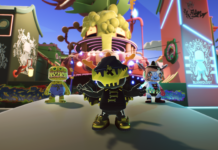Assassin's Creed is perhaps one of the most intriguing IPs to come out of this console generation, a refreshingly original title which stands out against a backdrop of generic first-person-shooters, and a crushing tide of casual games. The developers at Ubisoft have truly crafted a one-of-a-kind experience, one defined not just by its thrilling sandbox-style gameplay, but also by its incredibly intriguing plot; a mix of historical and science fiction far more ambitious than most video game storylines. This is why Assassin's Creed Revelations fills me with such a profound sense of ambivalence, as I am both thrilled for this exciting new chapter in the series, but also disappointed to know that it will mark the end of this fantastic saga.
It was with this volatile mixture of conflicting emotions churning in my stomach (also: a Sausage McMuffin from the airport McDonalds) that I recently flew out to Ubisoft's headquarters in downtown San Francisco, for an exclusive preview of this final chapter. And though I barely managed to scratch the surface of the game during the course three hour playthrough, I can say confidentially that the Assassin's Creed series ends on a fantastic high note, with the plot incredibly engaging and authentic, and all of the brilliant game-play elements introduced throughout the series now polished to an obvious perfection.

Ezio takes on some impressively decorated city guards.
Revelations again follows the story of Ezio Auditore da Firenze, the raven-haired Assassin who has acted as series protagonist from the second game onwards. As the Ubisoft rep explained to us journos, Ezio's motivation throughout the series has largely been one of revenge. In Assassin's Creed II, Ezio was spurned to action by the death of his father and brother, while in Brotherhood, his uncle's death is what forces him to again take up the Assassin's blade. The Ezio of Revelations then, is an older and wiser man, who for the first time decides to seek out his own destiny, rather than be forced into action by tragedy.
It is with this resolve that Ezio seeks out the library of his ancestor Altair, the white-cloaked protagonist from the original Assassin's Creed (who will also be playable within the game's special 'flashback' missions). Ezio hopes that this pilgrimage will help him to finally understand the truth of his mysterious bloodline, as well as the mysterious 'Pieces of Eden,' the supernatural artifacts for the Assassin's guild and the knights Templar have been waging a never-ending war to control. As seen from the much-discussed E3 trailer, Ezio's arrival at the library is met by an ambush by the Templars. Though Ezio manages to narrowly escape his untimely fate, this encounter sets the stage for an epic race between these warring factions, as both sides now seek out the five keys needed to unlock the depths of the library, which are scattered throughout the ancient world.
The E3 2011 cinematic trailer, showing Ezio's capture and escape from the Templars.
My playthrough skipped over the first chapter, which apparently deals with Ezio's initial escape from the Templars at the library. Instead I started with the second "sequence," where the aging Assassin arrives by boat in the bustling city of Constantinople – known to the locals as Istanbul. Without the sheen of the trailer's beautiful CG, Ezio's age is much more apparent. His beard is speckled with white hairs, the lines in his face run long, and he seems to have assumed the demeanor of an old and wise master.
Stepping off the boat, Ezio meets Yusef Tazim, the young leader of Constantinople's Assassin's guild, who acts an excellent youthful foil to this graying master. Yusef explains the city's troubles to Ezio as they pace the city streets, askuing for the master Assassin's help in ridding the city of invading Templars.
As the player has assumedly been re-taught the basic controls and features of Assassin's Creed throughout the first sequence, this second chapter begins with Yusef introducing players to a variety of features new to the series, with the cocky guide playfully teasing Ezio for not being familiar with these important tools.
Perhaps the most important new addition to Ezio's arsenal is the hook-blade, a incredibly versatile tool with a rather unimaginative name. Extending from a sleeve, the hook-blade greatly improves the already thrilling free-running mechanics of the series, extending Ezio's reach by a foot or two. Though that may not sound like much, this added reach enables Ezio to snag onto high ledges, scaling the sides of buildings at an incredible pace. More importantly, the hook-blade allows Ezio to complete previously-suicidal long jumps, letting him easily hook the edges of building rooftops at the end of his jumping arc. Many times throughout the playthrough I found myself misjudging a jump, though on the way down Ezio would usually manage to find something to hook onto, sparing me the otherwise deadly fall damage.

Yusef introduces Ezio to the hook-blade and use of ziplines.
The hook-blade also allows Ezio to take advantage of another exciting new feature: ziplines. Scattered around the city, these lengths of rope allow for easy travel across rooftops, though double as another method of Assassination, with any hapless victims who happen to be standing beneath a zipline practically inviting the game's gratuitous death-from-above scene. And though the hook blade seems best used as a climbing tool, it also had some other interesting uses. One particularly disturbing maneuver was termed the "hook and run," letting sprinting players sink their hook-blade into a hapless pedestrian's neck, and vault over them like a gymnast. An extreme method of navigating crowds, though the move is apparently non-lethal, meaning you can happily maim civilians without lowering that ever-crucial synchronization ratio.
The second piece of ordinance Yusef introduces to Ezio are bombs, an item-type which looks to play a major role in the game, as evidenced by the fact that the numerous chests found scattered about the city contained mostly bomb-making materials.. Though the standard smoke bomb featured in previous Assassin's Creed titles returns, Ezio will now have access to an entire library of possible bomb types, all useful for different situations. For instance, Yusef first has Ezio toss a simple cherry bomb into a crowded city square, the gunshot-like noise dragging a pair of guards away from their posts so that the two Assassins can continue into the city. Though I didn't get a chance to investigate the game's bomb-crafting mode, it definitely seems like stockpiling a healthy assortment of explosives will prove useful in this race for the library keys.
Following these minor introductory missions, the first true Templar assault on the assassin's guild began. Here I was very surprised to find myself playing a tower-defense simulator, dispatching assassins to rooftops in order to halt an advancing Templar horde. The mode will be very familiar to tower defense fans. As Ezio, you remain stationary on a central rooftop looking out over the city street, with Templars rushing in from the left towards the guild headquarters on the right. Using a cursor, players must wisely spend their morale points on the units best suited to taking down the approaching enemies, with each assassin type boasting various strengths and weaknesses. Archers are your standard cheap and efficient turrets, while riflemen are a bit more expensive but can puncture armored foes. Then there are special units such as leaders, who have to be placed atop a rooftop before any other units can be assigned there, and barricades, which are placed in the street to halt the advance of Templars. Killing Templars earns additional morale points, allowing Ezio to fill the rooftops with ever-more assassins. And perhaps coolest of all was the special cannon attack, which though the meter takes time to recharge, was excellent at blasting through tens of baddies, as well as demolishing the massive siege-engine which appeared as the boss of this short segment.

Many opponents wield firearms. Best to stay on their good side!
The final culmination of the initial Constantinople chapter came in the form of a dinner party, thrown in celebration of the arriving Ottoman prince. The Templars, remnants of Constantine II's Byzantine rule, apparently hate this man for historical reasons I will not claim to know (history majors help me out!). The Assassin's guild learns that the Templars plan to assassinate the prince during the party, and decide the best way to gain access to the private event is to disguise themselves as minstrels.
What follows is rather humorous sequence, where the assassins decide that rather than simply buying some silk outfits and lutes, they'd be better off beating up some unfortunate musicians, and dumping their limp bodies in some nearby wheelbarrows. I had a bit of trouble accomplishing this part without the guards taking notice, though eventually I got Ezio and his friends properly adorned in their adorable short pants, Ezio's limited musical skills gaining the band entry to the party.
Within the festival, Ezio is tasked with using his "eagle sense" to hone in and locate the potential assassins within the crowd. Once the traitor is discovered, a glowing beacon shows Ezio where to stand and play his ridiculous song (accomplished by absent-mindedly mashing face buttons), the inebriated party-goers so amused that they seem oblivious to the fact that a man is having his throat slit not two-feet behind them.
Ezio doesn't have long to bask in the prince's gratitude however, as the sequence ends with Ezio learning the location of one of the keys, and leaving in search of it. I was not able to discover where though, as my play-through jumped ahead to sequence four, which began with Ezio seeking out a book in a city library. This begins the game's first Altair mission, giving players control of the fabled Assassin ancestor for the first time since Assassin's Creed II. The developers told me that these so-called "book missions" are common throughout the game, as Brotherhood seeks to finally unite the plot's three timelines, and give players some insight into what happened to Altair following the original game.

Ezio talks with who appears to be his wife. The death of their son features as a plot point within the flashback missions.
This first Altair mission takes place immediately following the first game's ending, with Altair attempting to burn the body of Al-Mualim to assure that the corrupted guild leader will not return. Altair is confronted by fellow Assassin Abbas, who questions whether Altair's claim of the Al-Mualim's betrayal is valid. This dispute erupts into a riot within the hometown of the Assassins, forcing players to skillfully disarm their fellow Assassins, attempting to prove Altair's innocence through a show of non-violence. Following this, Abbas seizes the Apple of Eden artifact for himself, with Altair racing against the clock to scale the tower and subdue Abbas before the Apple's overwhelming power destroys the village.
Sadly, my play-through ended just as Altair wretched the powerful artifact from Abbas's hand. I did peek in on another player who managed to arrive at the second Altair chapter, where a future Altair apparently seeks revenge for the death of his son against Abbas, who is now a powerful and corrupt leader of his own faction. I also only got a brief look at the expanded assassin recruitment system, though I did learn that layers of complexity have been added to this feature since it appeared in Brotherhood, and that these recruited assassins will continue to aid in battle, and that collecting and powering-up numerous assassin allies will be crucial in defending cities from the ever-present Templar threat.

A mysterious female assassin indulges her opponent's foot fetish.
Again, Assassin's Creed Revelations looks to be a top-tier title on the strength of its story and gameplay alone. But what really caught my eyes was the stunning attention to detail. Each of the ancient cities has been partially recreated with the help of authentic documents and maps, and it truly feels as though you've stepped back in time. But more importantly, is just how real these environments feel. Unlike other sandbox-style games, the world of Revelations feels truly alive. NPCs barter for goods in the street, stop and listen to the speeches of street philosophers, or give chase after Ezio begging for money (these lot often catch a punch to the nose). Once I was even accosted by an anonymous mugger, who sadly caught a blade through the stomach for his indiscretion. This level of detail extends to even superfluous elements. Riding down a zipline you'll see frayed bits of rope being shaved off by the hook-blade, following the Ottoman prince's party you'll find servants sweeping the square and collecting up food-stained dishes.
In short, now is not the time to lament the passing of this wonderful series, but instead to embrace what stands to be the greatest chapter in its history. Ubisoft has clearly poured their hearts and souls into this game, and Assassin's Creed Revelations is a definite contender for game of the year.
November 15th is surely a day many gamers will be marking on your calendars. I'll be one of them.










